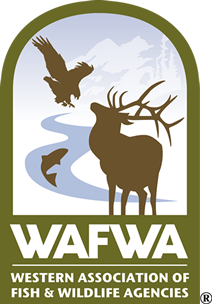WAFWA’s Strategic Plan 2019-2024

Approved: January 6, 2019
Western Association of Fish and Wildlife Agencies
2700 W. Airport Way
Boise, ID 83705
www.wafwa.org
Our aspirations for this plan are to:
• Set direction and priorities so people know what they should be working on, and what they should be working on first;
• Get everyone on the same page to ensure that leadership and the various programs and projects of WAFWA and the personnel associated with them are moving forward, together;
• Simplify decision-making so it is easy to say “yes” to work that has the most value for WAFWA’s mission and there is no trouble saying “no” to work that does not fit; and
• Communicate WAFWA’s message so internal and external stakeholders are clear about what WAFWA believes is the positive way forward.
WAFWA’s 2019-2024 Goals and Strategies
Goal 1. Advocate for the authorities and jurisdictional responsibilities of member agencies.
Strategies:
a. Support coordinated legal representation and policy advocacy on issues that cross WAFWA jurisdictional boundaries
b. Advocate to Congress and federal agencies for WAFWA member states’ authorities.
c. Promote the tenets of the North American Model of Fish and Wildlife Conservation while respecting each member’s choice and use of a conservation model
d. Identify and share legal and policy resources with members, e.g., sample rule language for conservation authority
e. Advocate creation of wildlife habitat values and funding in other government programs affecting WAFWA’s mission (e.g., the Farm Bill)
Goal 2. Support multi-jurisdictional and landscape-scale fish and wildlife conservation and research initiatives.
Strategies:
a. Facilitate wildlife management coordination, standards, and best practices across WAFWA jurisdictional boundaries
b. Facilitate research and stock assessment activities and standards across WAFWA jurisdictional boundaries
c. Facilitate rapid response capability of members to important emerging issues
d. Facilitate programs and projects that address the highest priority resource challenges as agreed to by WAFWA leadership
Goal 3. Ensure the financial sustainability of WAFWA.
Strategies:
a. Develop diverse revenue streams to reduce WAFWA reliance on state wildlife agency funding
b. Engage funders in providing ongoing maintenance and operations support after conservation actions are taken
c. Consider costs of initiatives and activities more rigorously into WAFWA priority setting and business strategies
d. Protect WAFWA’s proprietary interests in intellectual property, technology, and products
e. Facilitate partnerships with other managers and with conservation stakeholders
Goal 4. Optimize operational effectiveness.
Strategies:
a. Improve WAFWA governance and work team operations (e.g., assess the need to continue work teams and possibly establish new work teams; review the roster of work teams, their structure, and functions)
b. Increase communications, coordination, and interactions among WAFWA work teams
c. Maintain effective coordination, communication, reporting, and archiving of work team outputs
d. Maintain an effective WAFWA workforce and WAFWA staff’s technology capacity
e. Maintain sound cost accounting, business operations, policies, and procedures for WAFWA operations and support of work teams
f. Offer support services to members and customers (e.g., administration, business development, grants management, and project management)
Goal 5. Advance information and technology development, sharing, and management.
Strategies:
a. Facilitate development of technology supports to meet needs that cross WAFWA jurisdictional boundaries
b. Facilitate combining member resources to complete high priority IT-related projects and initiatives
c. Facilitate development of data acquisition, management, coordination, and sharing to meet needs that cross WAFWA jurisdictional boundaries
d. Facilitate expansion of data and information use and sharing with international partners
e. Facilitate WAFWA information and data use by outside entities to meet WAFWA’s mission
Goal 6. Promote leadership development, diversity, and inclusiveness in the Western fish and wildlife management community and WAFWA operations.
Strategies:
a. Facilitate leadership training focused on WAFWA agencies
b. Recruit legal expertise involvement into WAFWA work team efforts (e.g., attorneys, law students, presence at legal conferences)
c. Increase Native American wildlife manager and organization leadership involvement in WAFWA
d. Facilitate broader stakeholder and partnership involvement in WAFWA
e. More directly use social science and human dimensions to increase stakeholder engagement and partnership in wildlife conservation
f. Establish best practices for promoting diversity in WAFWA members’ workforces
Goal 7. Facilitate effective partnerships and communication among members and with a broader community.
Strategies:
a. Improve orientation for new WAFWA leadership appointees on WAFWA operations and managerial effectiveness in those positions
b. Improve the network cohesiveness and collaborations among legislative leads of member agencies
c. Increase awareness of WAFWA and its mission by agency employees who are not well informed about WAFWA
d. Increase marketing awareness of WAFWA generally and marketing of wildlife conservation values in the West
e. Improve participation in WAFWA meetings, especially work team member participation in the summer meeting
f. Coordinate multi-jurisdictional and regional message development and delivery to stakeholders
END